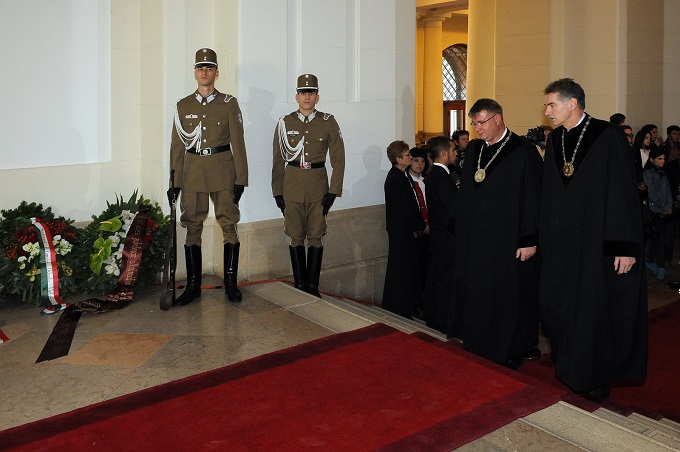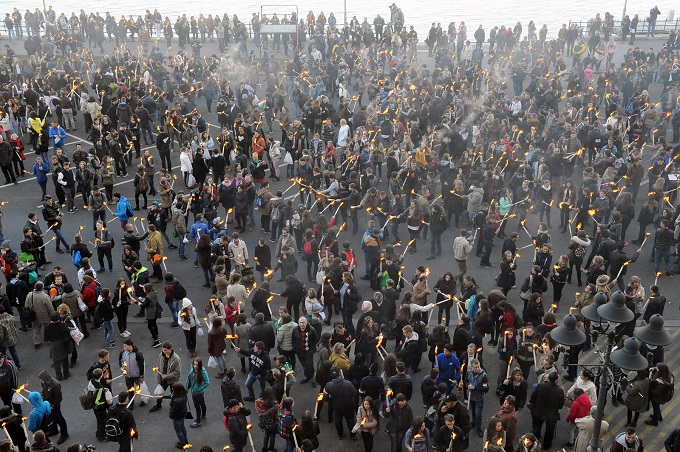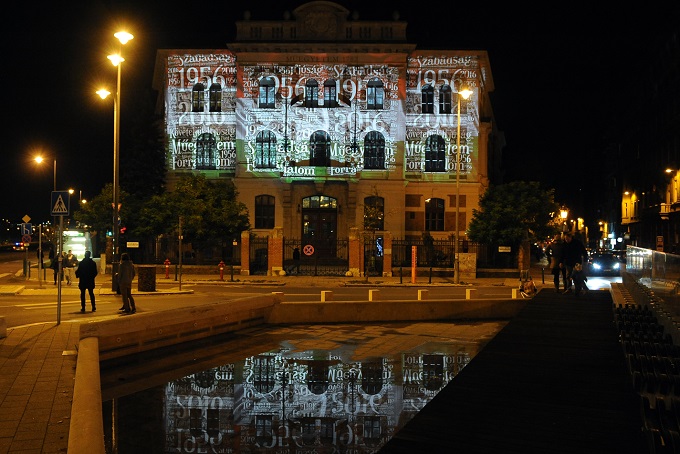2016. November 02.
A commemoration and a reunion of the historic years’ alumni were held at BME on the eve of the national holiday of 23 October. Light painting illuminated buildings K and Ch until midnight.
"Dear compatriots, sixty years ago the idea of freedom sprang to life in the minds of the students having a rally here, and then found its way to the whole nation", emphasized János Józsa, member of the Academy, rector of BME in his welcoming speech at the commemoration 1956-2016 – A nation made history held in the assembly hall of the university. As a follow-on the guests, including the leaders and staff of BME, had a talk with the alumni of the historic years. The guests entered the hall behind the mace-bearer of BME and the flag of ’56.

The audience in the ceremonially decorated assembly hall was made up of the 50 guests of BME, another 50 invitees of the Freedom Fighters Foundation, former students from 1956 with persons accompanying them, and young people. On the dais were seated 140 former students, and in the front rows sat dignitaries including Bence Rétvári, parliamentary state secretary of the Ministry of Human Resources, Zsolt Csampa, deputy state secretary responsible for local government coordination in the Ministry of Interior, Attila Aszódi, government commissioner of the Paks Nuclear Power Plant, Etelka Barsi Pataky, chairwoman of the Hungarian Chamber of Engineers, Ágnes Kovács Tóth, chief of staff of the Mayor’s Office, Tamás Hoffmann, mayor of Újbuda, Péter Biró, and Gábor Péceli, members of the Academy, former rectors of BME, György Pokol, former dean of BME VBK, director general of MTA TTK, and József Bokor, member of the Academy, director of science of MTA SZTAKI, professor of BME KJK.

The VIP guests in attendance were: Dalma Mádl, widow of former President of Hungary Ferenc Mádl, Zoltán Vajna, member of the Academy, professor Árpád Bernáth, Ödön Hajtó, chairman of the University of Technology 1956 Foundation, József Halzl, chairman of Rákóczi Association, Ferenc Kassai, chairman of the Budapest and Pest County Chamber of Engineers, Katalin Radnai Fogarasi, general director of the National Heritage Institute, László Regéczy Nagy, chairman of the Historic Justice Committee, and Edina Koszmovszki, who read out the students’ 16-point list of demands to the crowd gathered in front of the national radio station’s building sixty years ago. On behalf of BME, rector János Józsa was accompanied by Gyula Barta-Eke, chancellor of BME, Krisztina László and Károly Veszprémi, vice-rectors for international affairs and education, respectively, deans László Dunai, Tibor Czigány, Ferenc Faigl, János Pipek, István Varga, and Dávid Krisztián, president of BME EHK.

Az ünnepség kiemelt meghívottai közül a rektor név szerint köszöntötte a tengerentúlon Fekete Tamást, a Forradalmi Bizottság egyetlen élő tagját, a Műegyetem akkori fiatal oktatóját, valamint Rétvári Bence államtitkárt és feleségét, továbbá Schmidt Mária kormánybiztost, az ünnepség díszszónokát, Mádl Dalma asszonyt, Hajtó Ödönt, az ünnepség másik díszszónokát, Halzl Józsefet, a Rákóczi Szövetség elnökét és a szervezet által hívott felvidéki fiatalokat, továbbá a Műegyetem felső vezetőit, kancellárját, az EHK elnökét, valamint az Egyetem diákjait. Szólt még a köztársasági elnök, az önkormányzatok és a kormányzat tisztségviselőiről, köztük Hoffman Tamás újbudai polgármesterről, és a szakmai szervezetek megjelent vezetőit köszöntve emelte ki Barsiné Pataki Etelkát, a Magyar Mérnöki Kamara elnökét.

János Józsa turned to the audience in the assembly hall, and those watching the ceremony on the projection screen in front of building K, and recalled a talk with Géza M. Tóth, director, rector of the University of Theatre and Film Arts about BME’s pasta bridge building contest. “By increasing the load, the pasta strands snap suddenly and incredibly fast having reached tolerance limit.” That is how the world renowned director imagined the situation 60 years ago, when, as János Józsa described, “the load of the system exceeded the tensile strength of the nerves of a large number of students, the constraints were broken, and the students swarmed the city uncontrollably.”
"The more and more unbearable constraints that people, be they slaves or students, break free of uncontrollably once they unite. They cannot wait any longer for the slave owner, or in our case the West in 1956, to set them free. They want to free themselves", added the rector, who arrived from the Opera House’s ceremonial performance of Khatsaturjan's Spartacus. János Józsa called for a respectful and solemn commemoration, adding that the stela mounted on the main building of BME, signifying that the university was from Saturday on an official historic memorial, had been placed there in memory of the revolutionary spirit described above.


The 16 points that made up the political agenda of the revolution were created at the student rally held in the assembly hall of BME on 22 October, 1956. The next day the students of BME copied and distributed this list of demands throughout the city. That same day the silent demonstration that was followed by the toppling of Stalin’s statue, the siege of the national radio’s building, and the fight for freedom, started from BME, too.
|
For a free country, the official song of the 1956 commemorative year by Desmond Child, and the songs Even then ’56 and Handshake were perfomed at the ceremony by Tamás Szarka, the Ghymes band and the Symphonic Orchestra of BME that provided music for the entire event. The orchestra conducted by Dániel Erdélyi played Beethoven’s Egmont Overture that became a symbol of the revolution during the wreath-laying ceremony.
|
Ödön Hajtó, chairman of BME’s 1956 Memorial Committee, and a representative of the former students, primarily addressing his fellow students recalled the events at BME on 22 October, 1956, emphasizing that the students had the courage to rebel against an untolerable system on that day sixty years ago. "The whole country was smoldering like embers, but the embers were covered by the black mud of tyranny and intimidation. The students of BME were pushing the limits", said Ödön Hajtó, presenting the final version of BME’s 16 points.

"We are at a symbolic site of 1956, in the very assembly hall, where the Hungarian students earned their place in the country’s history forever after. The tension grew in them, and they were ablaze with the desire to seek justice between 1945 and 1956. There were a lot of them, they were bright and brave", Mária Schmidt, government commissioner of the 1956 Commemorative Year, and co-chair of the 1956 Memorial Committee described the tone of the events 60 years ago, and the attitude of the participants. "Their strength and courage were such as to make every well-meaning Hungarian stand by them in a matter of hours, and the revolution prevailed”, she added. She noted that the following days might be best described as the two weeks of giving hope to and setting an example for those oppressed by communism in the entire region. She also remarked that the more than 100 invitees of Hungary had come from 27 countries of 4 continents to celebrate. "What they have in common is the fact that their hearts beat faster when 1956 is mentioned", she stressed, welcoming those that stood by the Hungarian way sixty years ago, and their children, and grandchildren as well. "Barely 300 hours passed between the glorious afternoon of 23 October and the freezing dawn of 4 November. 300 hours of freedom were granted, and the whole world has respected this sliver of time. We should appreciate it, too", she urged the audience.


"We pay tribute to determination, courage, and humanity", said Csaba Botka from Novi Sad. He assessed the legacy of ’56 from the point of view of the Hungarian minority youth in the neighbouring countries. "While we face the challenges of our environments, we also need to identify the problems in our communities, and strive to survive. Let’s be determined, and work together", he asked the young generations living in the Carpathian basin.

Next, on behalf of the Government of Hungary, government commissioner Mária Schmidt, co-chair of the 1956 Memorial Committee laid a wreath at the memorial plaque of the heroic dead of BME to the tunes of Beethoven’s music. Wreaths were also placed on behalf of the President of Hungary János Áder by brigadier general László Szegő, on behalf of the 1956 Memorial Committee by chairman Ödön Hajtó, on behalf of the Rákóczi Association by chairman József Halzl, and on behalf of the students of ’56 at the University of Szeged by Tamás Kiss. On behalf of the students Dávid Krisztián, president of BME EHK, and Csaba Botka, ethnic Hungarian student from Serbia laid wreaths. On behalf of the local government of Budapest Újbuda, mayor Tamás Hoffman, and on behalf of the National Historic Memorial and Tribute Committee and the National Heritage Institute, general director Katalin Radnai Fogarasi paid their respects. On behalf of BME, rector János Józsa, and chancellor Gyula Barta-Eke paid tribute to the dead.

The stela inaugurated on the eve of the national holiday by the National Heritage Institute commemorates the facts that the demands put to the political establishment gained wider publicity after the student rally held at the historic campus of BME on 22 October, 1956, and that the demonstration of the students started the revolution in the capital on 23 October. The stela was inaugurated by Katalin Radnai Fogarasi, general director of the National Heritage Institute, János Józsa, member of the Academy, rector of BME, and Ödön Hajtó, chairman of the University of Technology 1956 Memorial Committee. By the inauguration of the stela, the building of BME has become an official historic memorial, the only university to have done so.


|
Historic memorials are important memorial sites that have national, religious, regional or ethnic significance. Although they are often excellent architectural works of art, too, they are not so much noted for their monumental values as their outstanding historic roles. They make it possible for the visitors to experience the landmark events, the tragedies, but also the glorious moments of Hungary’s history. As of today, there are 46 historic memorials in the country, whose significance was confirmed by a government decree on the recommendation of the National Historic Memorial and Tribute Committee (source: National Heritage Institute). (Editor’s note: Among the historic memorials we find the building of the Hungarian Academy of Sciences as an outstanding place of Hungarian nation-building in the 19th century, Corvin Square in Pest, an emblematic site of the 1956 Revolution and Freedom Fight, and also 60 Andrássy boulevard, a symbol of political terror, or the Batthyány lantern, a site for political and historical commemorations.) |

Before the ceremony Chancellor Gyula Barta-Eke, and Technical Vice-Chancellor Zoltán Mikó laid a wreath at the memorial plaque by the university’s entrance on Budafoki street. After the commemoration the leaders of BME and their guests paid their tribute at the memorial in the backyard by the library.

After the reunion of the historic years’ alumni, when it got dark, the traditional torchlight procession of the Rákóczi Association started from the university to Bem Square. When the front of the procession, led by three authentic Csepel trucks, got to Szent Gellért Square, the rear just left the university. From Gellért Square on period trams carried those with reduced mobility along the road of memory leading to Imre Nagy Square, where the Flame of Revolution flared up.





- TJ -
Photo: Philip János, Takács Ildikó



